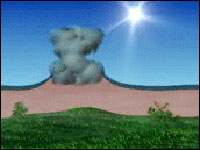What do the Amazon Basin and Sahara Desert have in common? They are intricately linked by dust and climate and both belong to a family of hotspots or “Achilles’ heels” that have a profound impact on the global environment, says Professor John Schellnhuber, speaking at the EuroScience Forum in Stockholm today.
Dust from the Sahara Desert fertilises the Amazon, increasing the abundance of life there, says Professor Schellnhuber, IGBP* Science Ambassador and Director of the UK-based
The first 40 million years of Arctic climate history was recovered from beneath the Arctic sea floor on Monday 23 August.
After four days drilling in hazardous conditions the Integrated Ocean Drilling Program’s Arctic Coring Expedition retrieved a 272m core before sea ice forced the work to be abandoned.
The deepest ever Arctic borehole, just 233 kilometres from the North Pole, was interrupted late on Monday when very thick, moving ice floes meant that even the world’s most p
The one-night-a-year spawning of massive star corals (Montastraea species) off of the Florida coast generates millions of infant corals, each of which has the potential to help replenish coral reefs that have undergone significant environmental damage in recent years.
Even so, the chance that these bundles of eggs and sperm released in early September will result in healthy new individuals capable of replenishing reefs depends on many factors, most importantly the establishment of sy
As the advance of global warming becomes more certain, accurate predictions about its impacts are still largely guesswork. How can we know what long-term warming will do to complex ecosystems? One way is to do a large experiment and see what happens. A new study published in the journal Ecology shows that artificially warming the seawater by 3.5oC in a California bay had dramatic effects on 150 species of seaweeds and animals.
David Schiel (University of Canterbury in Christchurch, New Zeal

While the Earth is moistened by rainfall, scientists believe that the water in soil can, in turn, influence rainfall both regionally and globally. Forecasters, water resource managers and farmers may benefit once this connection is better understood.
A NASA researcher led an effort that used a dozen computer models to locate “hot spots” around the world where soil moisture may strongly affect rainfall during northern hemisphere summertime. The results appear in the August 20 issue
Invasive species may cause severe economic losses. Thus the hot debate regarding the ecological mechanisms determining the outcome of biological invasions is of equal interest to scientific and business communities. Do invaders bump residents out by competing with them for scarce resources, or do they merely move in without causing harm to their neighbors?
In one of the first environmental impact studies ever, the Smithsonian Institution’s 1910 Panama Biological Survey provided ba